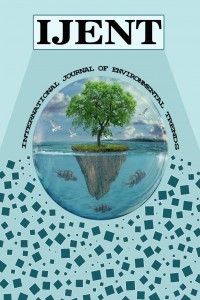Characterization of Reverse Osmosis Concentrates from Drinking Water Reclamation Sources in Makurdi Metropolis-Nigeria
Characterization of Reverse Osmosis Concentrates from Drinking Water Reclamation Sources in Makurdi Metropolis-Nigeria
___
- [1] T. Wintgens, T. Melin, A. Schiller, S. Khan, M. Muston, D. Bixio, and C. Thoeye, “The Role of Membrane Processes in Municipal Wastewater Reclamation and Reuse”. Desalination vol. 178, pp. 1-11, 2005.
- [2] P. Chelme-Ayala, D.W. Smith, and M.G. El-Din, “Membrane Concentrate Management: A Comparative Critical Review”. Journal of Environmental Engineering and Science, vol. 36, no. 6, pp. 1107-1119, 2009. [3] J. Shahzad, “Forward Osmosis for the Treatment of Reverse Osmosis Concentrate from Water Reclamation: Process Performance and Fouling Control”. Phd Thesis, Department of Civil and Environmental Engineering, University of Technology Sydney, Australia, 2013, 224pp.
- [4] P.Westerhoff, H. Moon, D. Minakata, and J. Crittenden, “Oxidation of Organics in Retentates from Reverse Osmosis Wastewater Reuse Facilities”. Water Research vol. 43, no.16, pp. 3992-3998, 2009.
- [5] S.J. Khan, D. Murchland, M. Rhodes, and T.D. Waite, “Management of Concentrated Waste Streams from High Pressure Membrane Water Treatment Systems”. Critical Reviews in Environmental Science and Technology vol. 39, pp. 367-415, 2009.
- [6] S. Pradhan, L. Fan, F. Roddick, E. Shahsavari, and A. Ball, “Impact of Salinity on Organic Matter and Nitrogen Removal from a Municipal Wastewater RO Concentrate using Biologically Activated Carbon Coupled with UV/H2O2”, Water Research, vol. 94, pp. 103-110, 2016.
- [7] B. Van der Bruggen, L. Lejon, and C. Vandecasteele, “Reuse, Treatment, and Discharge of the Concentrate of Pressure-Driven Membrane Processes”. Environmental Science and Technology, vol. 37, pp. 3733, 2003.
- [8] R.T. Iwar, K. Ogedengbe, and L.A. Oparaku, “Temporal Variations in the Characteristics of Pre-Treated Effluents from a Brewery in Makurdi Metropolis-Nigeria”. American Journal of Environmental Protection, vol. 4, no. 2, pp. 55-60, 2016.
- [9] APHA, “Standard Methods for the Examination of Water and Wastewater,” American Public Health Association, Washington, D.C., 1998.
- [10] FAO, “Water quality for agriculture,” R.S. Ayers and D.W. Westcot, eds. FAO paper Rev. Rome, pp. 1-29, 1985. [11] USEPA. Onsite Wastewater Treatment Systems Manual. EPA/625/R-00/008, USEPA Office of Water, 2002.
- ISSN: 2602-4160
- Başlangıç: 2017
- Yayıncı: Muhammed Kamil ÖDEN
EFFECT OF IRRIGATION REGIMES BY MINI SPRINKLER ON CHEMICAL COMPOSITION OF ‘TOMBUL’ HAZELNUT KERNELS
Saim BOSTAN, Arif KÜLAHÇILAR, Tahsin TONKAZ
Raphael IWAR, Kamil KATİBİ, Bright NWANKPA
Hülya EÇEN ÇALIŞKAN, Hamza Savaş AYBERK
Ece SÖKMEN YILMAZ, Esra ERSOY ÖMEROĞLU, İsmail KARABOZ
Bahadır Çağrı BAYRAM, Nadir ERSEN, İlker AKYÜZ, Tutku ÜÇÜNCÜ, Kadri Cemil AKYÜZ
